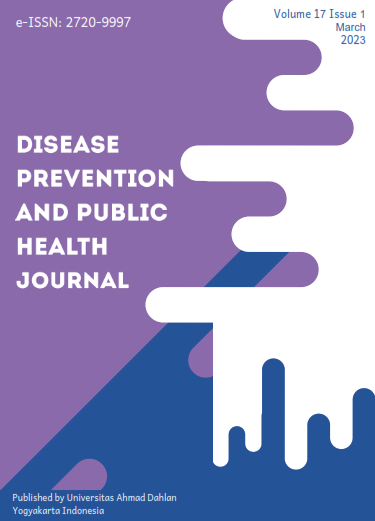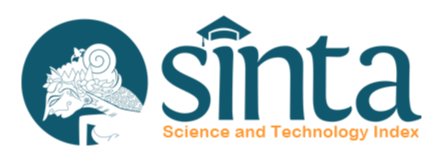The Source of Adolescents Reproductive Health Information and Dating Behavior Among Senior High School Students
DOI:
https://doi.org/10.12928/dpphj.v17i1.7165Keywords:
Behavior, Father, Mother, Love, TeenagerAbstract
Background: The adolescence period is a crucial time for laying the foundations of good health. Having access to high Adolescents Reproductive Health (ARH) information decreases premarital sex, child marriage, adolescent pregnancy, Sexually-transmitted infections (STIs), and HIV/Aids. Premarital sex was associated with dating behavior. About 57% of adolescents have dating behavior. This study aimed to analyze the source of adolescents’ reproductive health related to dating behavior among adolescents. Method: This was a cross-sectional study carried out in July-September 2022. The study population was high school students in Yogyakarta. A multistage random sampling technique was employed, involving 80 respondents. The instrument used was a questionnaire that has been tested. Data analysis in chi-square and logistic regression using statistical test software. Results: Females (56.1%) and males (43.9%) had dating behavior. The father’s education (p=0.012), the mother’s communication about ARH (p=0.040), and the father’s communication about ARH (p=0.018) were related to dating behavior among adolescents. Father’s education affects dating behavior among adolescents OR 5.01. Adolescents who have a father who graduated >12 years of education were 5 times more likely to have no dating behavior. Conclusion: The role of parents is needed to prevent dating behavior among adolescents.
References
World Health Organization, “Adolescents Health,” 2021. Available: https://www.who.int/health-topics/adolescent-health.
UNICEF (United Nations Children’s Fund), “Adolescents’ Profile 2021,” 2021. Available: https://www.unicef.org/indonesia/media/9546/file/Profil Remaja.pdf.
World Health Organization, “Adolescent Sexual Reproductive Health,” 2022. https://www.who.int/southeastasia/activities/adolescent-sexual-reproductive-health.
M. Rini and Y. D. Tjadikijanto, “Overview of the Planned Generation Program (GenRe) in Indonesia and in East Java Province in 2017,” Biometrics Popul. J., vol. 7, no. 2, p. 168, 2019, doi: 10.20473/jbk.v7i2.2018.168-177.
M. Liang et al., “The State of Adolescent Sexual and Reproductive Health,” J. Adolesc. Heal., vol. 65, no. 6, pp. S3–S15, 2019, doi: 10.1016/j.jadohealth.2019.09.015.
S. M. Ayu, L. Sofiana, M. Wibowo, E. Gustiana, and A. Setiawan, “Predisposing, Enabling and Reinforcing Factors of Premarital Sex Behavior in School Adolescents,” Public Heal. J., vol. 15, no. 1, pp. 29–38, 2019, doi: 10.15294/kemas.v15i1.14226.
R. B. Shrestha, “Premarital Sexual Behaviour and Its Impact on Health Among Adolescents,” J. Heal. Promot., vol. 7, no. June, pp. 43–52, 2019, doi: 10.3126/jhp.v7i0.25496.
E. K. Suryaningsih and M. L. Gau, “Factor Influence Pre-Marital Pregnancy in Yogyakarta, Indonesia: A Qualitative Study,” J. Heal. Technol. Assess. Midwifery, vol. 4, no. 1, pp. 1–7, 2021, doi: 10.31101/jhtam.1371.
S. Qomariah, “Dating Behavior Related to Premarital Sex Among Adolesecents,” Public Heal. J. Asclepius, vol. 2, no. 1, pp. 44–53, 2020, doi: 10.31539/jka.v2i1.585.
N. M. Cici, S. Notoatmojo, and L. Ulfa, “Determinant of Adolescents’ Dating Behavior,” J. Community Health, vol. 6, no. 3, pp. 272–280, 2021, doi: 10.25311/keskom.vol6.iss3.573.
C. Ohee, “The Effect of Relationship Status Towards Students’ Risky Dating Behavior,” Indones. J. Public Heal., vol. 13, no. 2, p. 269, 2019, doi: 10.20473/ijph.v13i2.2018.269-287.
T. Susanto et al., “Prevalence of Factors Related To Active Reproductive Health Behavior: A Cross-Sectional Study Indonesian Adolescent,” Epidemiol. Health, vol. 38, p. e2016041, 2018, doi: 10.4178/epih.e2016041.
G. K. Behulu, K. T. Anteneh, and G. L. Aynalem, “Premarital Sexual Intercourse and Associated Factors among Adolescent Students in Debre-Markos Town Secondary and Preparatory Schools, North West Ethiopia, 2017,” BMC Research Notes, vol. 12, no. 1. 2019, doi: 10.1186/s13104-019-4132-4.
V. Mai and S. Kittisuksathit, “Factors Influencing Pre-Marital Sexual Intercourse among Unmarried Young Individuals in Cambodia,” Makara J. Heal. Res., vol. 23, no. 3, pp. 143–149, 2019, doi: 10.7454/msk.v23i3.1157.
F. Mbadu Muanda, N. P. Gahungu, F. Wood, and J. T. Bertrand, “Attitudes toward Sexual and Reproductive Health among Adolescents and Young People in Urban and Rural DR Congo,” Reprod. Health, vol. 15, no. 1, pp. 1–14, 2018, doi: 10.1186/s12978-018-0517-4.
R. Santika and M. Z. Permana, “Exploring the Reasons Someone Dating in Emerging Adulthood,” J. Psychol., vol. 6, no. 2, pp. 101–112, 2021, doi: 10.24176/perseptual.v6i2.6042.
M. Gómez-López, C. Viejo, and R. Ortega-Ruiz, “Well-being and Romantic Relationships: A Systematic Review in Adolescence and Emerging Adulthood,” Int. J. Environ. Res. Public Health, vol. 16, no. 13, 2019, doi: 10.3390/ijerph16132415.
J. Kansky and J. P. Allen, “Long-term Risks and Possible Benefits Associated with Late Adolescent Romantic Relationship Quality,” J. Youth Adolesc., vol. 47, no. 7, pp. 1531–1544, 2018, doi: 10.1007/s10964-018-0813-x.
P. Datta, D. Cornell, and T. Konold, “Association of Teen Dating Aggression with Risk Behavior and Academic Adjustment,” J. Interpers. Violence, vol. 37, no. 7–8, pp. NP3930–NP3953, 2022, doi: 10.1177/0886260520951305.
M. Dosil, J. Jaureguizar, E. Bernaras, and J. Burges Sbicigo, “Teen Dating Violence, Sexism, and Resilience: A Multivariate Analysis,” Int. J. Environ. Res. Public Health, vol. 17, no. 8, 2020, doi: 10.3390/ijerph17082652.
U. N. H. Rights, “Young People Need Their Sexual and Reproductive Health and Rights,” 2021. https://www.ohchr.org/.
D. N. Budiharjo, E. Marianingsih Theresia, and H. Widyasih, “Factors Influencing to the Incidence of Teenage Pregnancy,” Matern. Child Health J., vol. 12, no. 2, pp. 124–128, 2018, doi: 10.29238/kia.v12i2.150.
J. M. Kyilleh, P. T. N. Tabong, and B. B. Konlaan, “Adolescents’ Reproductive Health Knowledge, Choices and Factors Affecting Reproductive Health Choices: A qualitative study in the West Gonja District in Northern region, Ghana,” BMC International Health and Human Rights, vol. 18, no. 1. 2018, doi: 10.1186/s12914-018-0147-5.
X. Chen, “Influence of Parents’ Education Level on Household Human Capital Investment,” Proc. - 2020 Int. Conf. E-Commerce Internet Technol. ECIT 2020, pp. 97–104, 2020, doi: 10.1109/ECIT50008.2020.00030.
R. Evans, L. Widman, K. Kamke, and J. L. Stewart, “Gender Differences in Parents’ Communication with their Adolescent Children About Sexual Risk and Sex-Positive Topics,” J. Sex Res., vol. 57, no. 2, pp. 177–188, 2020, doi: 10.1080/00224499.2019.1661345.
S. Kusheta, B. Bancha, Y. Habtu, D. Helamo, and S. Yohannes, “Adolescent-parent Communication on Sexual and Reproductive Health Issues and Its Factors Among Secondary and Preparatory School Students in Hadiya Zone, Southern Ethiopia: Institution Based Cross Sectional Study,” BMC Pediatr., vol. 19, no. 9, 2019, doi: https://doi.org/10.1186/s12887-018-1388-0.
S. Akuiyibo et al., “Impact of Peer Education on Sexual Health Knowledge among Adolescents and Young Persons in Two North Western states of Nigeria,” Reprod. Health, vol. 18, no. 1, pp. 1–8, 2021, doi: 10.1186/s12978-021-01251-3.
R. Keizer, K. O. W. Helmerhorst, and L. van R. Gelderen, “Perceived Quality of The Mother-Adolescent and Father-Adolescent Attachment Relationship and Adolescents’ Self-Esteem,” J. Youth Adolesc., vol. 48, pp. 1203–1217, 2019, doi: https://doi.org/10.1007/s10964-019-01007-0.
W. Kaczkowski and K. M. Swartout, “Exploring Gender Differences in Sexual and Reproductive Health Literacy among Young People from Refugee Backgrounds,” Cult. Heal. Sex., vol. 22, no. 4, pp. 369–384, 2020, doi: 10.1080/13691058.2019.1601772.
Y. H. Hadiwiardjo, M. C. Asiyanto, and C. A. Aprilia, “Effectiveness of leaflet and Film to Improve Knowledge Level about Puberty,” Dis. Prev. Public Heal. J., vol. 14, no. 1, p. 46, 2020, doi: 10.12928/dpphj.v14i1.1812.
H. Roberts, D. Angus Clark, C. Kalina, C. Sherman, M. M. Heitzeg, and B. M. Hicks, “Sexual Behavior and Substance Use in Adolescence and Young Adulthood: Non-Specific Associations Between A Range of Sexual Behaviors and Alcohol, Nicotine, and Marijuana Use,” Collabra Psychol., vol. 7, no. 1, pp. 1–17, 2021, doi: 10.1525/collabra.25526.
S. Y. Hastuti, I. Saleh, and I. Arfan, “Teenage Dating Behavior and Factors That Affect Dating Behavior in High School Students,” JUMANTIK, vol. 4, no. 2, pp. 1–14, 2017, doi: http://dx.doi.org/10.29406/jjum.v4i2.856.
A. K. Umaroh, C. Prastika, H. Herawati, S. Chalada, and H. Pratomo, “Dating Behavior among Adolescents during COVID-19 pandemics,” PREPOTIF Public Heal. J., vol. 5, no. 1, pp. 125–138, 2021, doi: 10.31004/prepotif.v5i1.1419.
E. Dwimawati and N. Anisa, “Factors Related to Knowledge Level about Adolescents Reproduction Health,” Promot. Students J. Public Heal., vol. 1, no. 2, pp. 80–86, 2018, doi: https://doi.org/10.33085/jkg.v1i2.3946.
M. Muñiz-Rivas, M. Vera, and A. Povedano-Díaz, “Parental Style, Dating Violence and Gender,” Int. J. Environ. Res. Public Health, vol. 16, no. 15, 2019, doi: 10.3390/ijerph16152722.
B. Yimer and W. Ashebir, “Parenting Perspective on the Psychosocial Correlates of Adolescent Sexual and Reproductive Health Behavior among High School Adolescents in Ethiopia,” Reprod. Health, vol. 16, no. 1, pp. 1–9, 2019, doi: 10.1186/s12978-019-0734-5.
Y. Sari and N. Aini, “Relationship of Predisposing, Enabling, and Reinforcing Factors Related to the Role of Parents in Providing Sex Education,” J. Glob. Heal., vol. 1, no. 2, pp. 87–93, 2018, doi: https://doi.org/10.33085/jkg.v1i2.3946.
T. Anitasari, I. Kusumaningrum, D. L. Suci, and D. Wulandari, “Parents Behavior for Delivering Adolescent Reproductive Health Education,” Int. J. Public Heal. Sci., vol. 11, no. 4, pp. 1202–1209, 2022, doi: 10.11591/ijphs.v11i4.21440.
C. J. Sun, E. S. Seloilwe, M. Magowe, K. S. Dithole, K. S. Miller, and J. S. St. Lawrence, “Gender Differences in Sexual and Reproductive Health Protective and Risk Factors of Batswana Adolescents: Implications for Parent and Adolescent Interventions,” AIDS Educ. Prev., vol. 30, no. 1, pp. 35–46, 2018, doi: 10.1521/aeap.2018.30.1.35.
E. P. Kusparlina, “The Relationship Between Knowledge of Reproductive Health and Sexuality Attitudes with Dating Behavior in High School Students,” Heal. Res. J. Forikes, vol. 11, pp. 90–95, 2020, doi: http://dx.doi.org/10.33846/sf11nk317.
R. P. H. R and A. C. W, “The relationship Between Knowledge and Mass Media Exposure with Adolescent Dating Behavior,” J. Fac. Public Heal., vol. 12, no. 1, pp. 60–67, 2018, doi: http://dx.doi.org/10.12928/kesmas.v12i1.6908.
V. Klein, I. Becker, and A. Štulhofer, “Parenting, Communication about Sexuality, and the Development of Adolescent Womens’ Sexual Agency: A Longitudinal Assessment,” J. Youth Adolesc., vol. 47, no. 7, pp. 1486–1498, 2018, doi: 10.1007/s10964-018-0873-y.
Downloads
Published
Issue
Section
License
Copyright (c) 2023 Universitas Ahmad Dahlan

This work is licensed under a Creative Commons Attribution-ShareAlike 4.0 International License.
Authors transfer the copyright and grant the Disease Prevention and Public Health Journal right of first publication with the work simultaneously licensed under a Creative Commons Attribution License (CC BY-SA 4.0) that allows others to share (copy and redistribute the material in any medium or format) and adapt (remix, transform, and build upon the material) the work for any purpose, even commercially with an acknowledgement of the work's authorship and initial publication in Disease Prevention and Public Health Journal. Authors are able to enter into separate, additional contractual arrangements for the non-exclusive distribution of the journal's published version of the work (e.g., post it to an institutional repository or publish it in a book), with an acknowledgement of its initial publication in Disease Prevention and Public Health Journal. Authors are permitted and encouraged to post their work online (e.g., in institutional repositories or on their website) prior to and during the submission process, as it can lead to productive exchanges, as well as earlier and greater citation of published work (See The Effect of Open Access).

This work is licensed under a Creative Commons Attribution-ShareAlike 4.0 International License.







